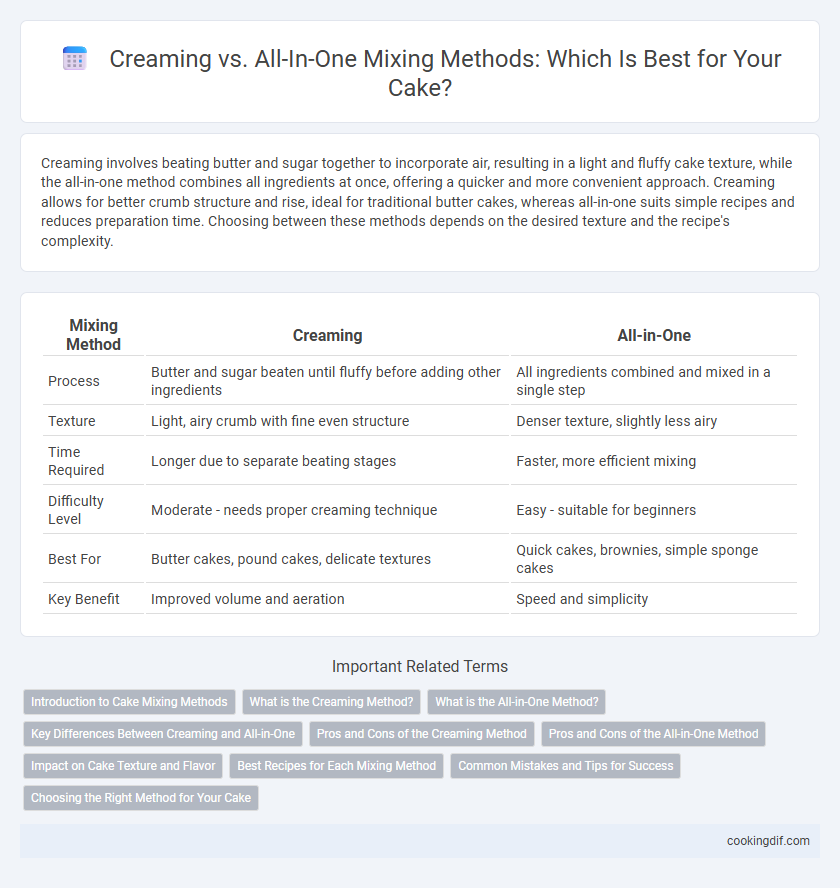Creaming involves beating butter and sugar together to incorporate air, resulting in a light and fluffy cake texture, while the all-in-one method combines all ingredients at once, offering a quicker and more convenient approach. Creaming allows for better crumb structure and rise, ideal for traditional butter cakes, whereas all-in-one suits simple recipes and reduces preparation time. Choosing between these methods depends on the desired texture and the recipe's complexity.
Table of Comparison
| Mixing Method | Creaming | All-in-One |
|---|---|---|
| Process | Butter and sugar beaten until fluffy before adding other ingredients | All ingredients combined and mixed in a single step |
| Texture | Light, airy crumb with fine even structure | Denser texture, slightly less airy |
| Time Required | Longer due to separate beating stages | Faster, more efficient mixing |
| Difficulty Level | Moderate - needs proper creaming technique | Easy - suitable for beginners |
| Best For | Butter cakes, pound cakes, delicate textures | Quick cakes, brownies, simple sponge cakes |
| Key Benefit | Improved volume and aeration | Speed and simplicity |
Introduction to Cake Mixing Methods
Creaming and all-in-one are fundamental cake mixing methods that impact texture and crumb structure. Creaming involves beating butter and sugar until light and fluffy, creating air pockets that produce a tender, airy cake. The all-in-one method combines all ingredients simultaneously for a quicker mix, resulting in a denser, moist cake ideal for beginners and efficient preparation.
What is the Creaming Method?
The Creaming Method involves beating butter and sugar together until light and fluffy, which incorporates air and provides a tender, airy texture in cakes. This technique helps dissolve the sugar and evenly distributes fat, improving the cake's crumb and volume. It is ideal for recipes that require a delicate structure, such as pound cakes and layer cakes.
What is the All-in-One Method?
The All-in-One method combines all ingredients--flour, sugar, fat, eggs, and liquid--into a single mixing step, simplifying the cake batter preparation. This technique streamlines the process, saving time and reducing the risk of overmixing by eliminating separate creaming of butter and sugar. Popular in sponge and buttercake recipes, the All-in-One method produces a consistent texture and moist crumb while enhancing efficiency in home baking.
Key Differences Between Creaming and All-in-One
Creaming involves beating butter and sugar together to incorporate air, creating a light and fluffy texture essential for traditional sponge cakes. The all-in-one method combines all ingredients simultaneously, saving time but often resulting in a denser crumb. Key differences include texture outcomes, mixing time, and the aeration process, with creaming producing lighter cakes and all-in-one offering simplicity and speed.
Pros and Cons of the Creaming Method
The creaming method, involving the thorough beating of butter and sugar, creates a light, airy texture by incorporating air that aids rising during baking. This technique produces cakes with a fine crumb and tender structure but requires softened butter and more mixing time, making it less convenient for quick recipes. However, it provides superior volume and even distribution of ingredients compared to the all-in-one method, which can result in denser cakes.
Pros and Cons of the All-in-One Method
The all-in-one method simplifies cake preparation by combining all ingredients simultaneously, reducing mixing time and minimizing equipment use. However, this approach can lead to uneven ingredient distribution, resulting in less consistent crumb texture and potential issues with aeration compared to the creaming method. Bakers seeking convenience may favor all-in-one, but those prioritizing precise texture and rise often prefer traditional creaming techniques.
Impact on Cake Texture and Flavor
Creaming involves beating butter and sugar until light and fluffy, incorporating air that creates a finer crumb and tender texture, enhancing the cake's moistness and richness in flavor. The all-in-one method mixes all ingredients simultaneously, which often results in denser cakes with a coarser crumb and less pronounced buttery notes. Choosing creaming yields lighter, more delicate cakes, while all-in-one provides convenience at the expense of texture and flavor complexity.
Best Recipes for Each Mixing Method
Creaming method excels with recipes like classic butter cakes and layered sponge cakes, where creamed butter and sugar create a light, airy texture crucial for rich flavors. The all-in-one method suits simple, moist cakes such as pound cakes and tray bakes by combining ingredients directly, streamlining preparation while maintaining even crumb structure. Selecting the right mixing method ensures optimal rise and texture, enhancing the overall quality of specific cake recipes.
Common Mistakes and Tips for Success
Using the creaming method, common mistakes include overbeating the butter and sugar, which can cause a dry, crumbly texture, and underbeating, leading to dense cakes. In the all-in-one method, improper ingredient temperature and inadequate mixing often result in uneven batter and dense crumb. For success, ensure butter and eggs are at room temperature in the creaming method, and thoroughly sift dry ingredients in the all-in-one method to promote even mixing and a light, tender cake.
Choosing the Right Method for Your Cake
Choosing the right mixing method for your cake is essential to achieve the desired texture and crumb. The creaming method, which involves beating butter and sugar until light and fluffy, is ideal for buttery, tender cakes with a fine crumb, while the all-in-one method saves time by combining all ingredients simultaneously, producing dense, moist cakes perfect for quick recipes. Understanding the cake type and desired outcome guides bakers in selecting the optimal mixing technique for consistent results.
Creaming vs All-in-one for mixing methods Infographic

 cookingdif.com
cookingdif.com